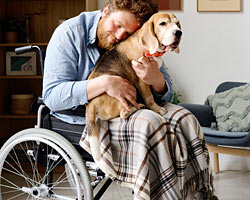When caring for patients, care providers are concerned with patients’ physical needs as well as their emotional well-being. One way to improve a patient’s mood is to schedule a visit with a therapy pet. Whether it’s a cat, dog or a different animal altogether, pets can enter a room and immediately make it a brighter, happier place to be. A recent study reported that patients who spent 10 minutes with a therapy dog reported less pain than those getting conventional treatment alone.
Who Benefits From Pet Therapy?
 The short answer is that pet therapy is usually a positive experience for everyone. From small children in PICU units, to veterans returning from war, to patients in Hospice care, therapy dogs and cats can be counted on to brighten the spirits of people of every age. What’s more, introducing a therapy animal is not just a boost of morale for patients but for their families as well. It can be difficult seeing a loved one in end-of-life care, particularly for younger family members. When a therapy cat comes into the room, ready to curl up on a lap, it makes everyone smile.
The short answer is that pet therapy is usually a positive experience for everyone. From small children in PICU units, to veterans returning from war, to patients in Hospice care, therapy dogs and cats can be counted on to brighten the spirits of people of every age. What’s more, introducing a therapy animal is not just a boost of morale for patients but for their families as well. It can be difficult seeing a loved one in end-of-life care, particularly for younger family members. When a therapy cat comes into the room, ready to curl up on a lap, it makes everyone smile.
How Does Pet Therapy Help?
 When you bring a therapy pet into a health care setting, it provides many benefits to the patients, families and health care staff. In addition to making people happier, there are also medical benefits as well. Patients have been found to display some of the following benefits after time with a therapy animal:
When you bring a therapy pet into a health care setting, it provides many benefits to the patients, families and health care staff. In addition to making people happier, there are also medical benefits as well. Patients have been found to display some of the following benefits after time with a therapy animal:
- Reduced physical pain
- Reduced anxiety
- Reduced blood pressure
- Elevated spirits and decreased mental pain
- Increased social interaction
- Decreased boredom
 Research suggests that practicing “Mindfulness“, a relaxation technique which focuses on being in the present, can help reduce pain and anxiety by shifting the focus away from emotional, mental, or physical distress. The benefits of this practice can extend from patient to caregiver, including nursing staff. Inherently, animals are masters of Mindfulness – and dogs, in particular, model unconditional love. Interacting with a pet can provide a similar opportunity to embrace the present moment with kindness and compassion – in peace and without judgement. This “Animal Assisted Mindfulness” can impart a sense of well-being and connection.
Research suggests that practicing “Mindfulness“, a relaxation technique which focuses on being in the present, can help reduce pain and anxiety by shifting the focus away from emotional, mental, or physical distress. The benefits of this practice can extend from patient to caregiver, including nursing staff. Inherently, animals are masters of Mindfulness – and dogs, in particular, model unconditional love. Interacting with a pet can provide a similar opportunity to embrace the present moment with kindness and compassion – in peace and without judgement. This “Animal Assisted Mindfulness” can impart a sense of well-being and connection.
What Kinds of Animals Can Be Therapy Pets?
 The most common therapy animals are, unsurprisingly, cats and dogs. There is no one correct type of therapy cat or therapy dog, however. From Nikita, a large German Shepherd who brings joy to residents in Virginia hospice situations, to Cody, a Golden Retriever uplifting spirits at Tucson Medical Center, dogs of all shapes and sizes can be excellent therapy animals. The breed of the dog is not important; instead, what is important is the behavior of the pet in question. If it’s loving, gentle and disciplined around new people, it’s a candidate for therapy service. It’s important that the pet be willing to get close and show affection to those that it meets, but often patients are in delicate states, and so a pet jumping all over them aggressively would be undesirable.
The most common therapy animals are, unsurprisingly, cats and dogs. There is no one correct type of therapy cat or therapy dog, however. From Nikita, a large German Shepherd who brings joy to residents in Virginia hospice situations, to Cody, a Golden Retriever uplifting spirits at Tucson Medical Center, dogs of all shapes and sizes can be excellent therapy animals. The breed of the dog is not important; instead, what is important is the behavior of the pet in question. If it’s loving, gentle and disciplined around new people, it’s a candidate for therapy service. It’s important that the pet be willing to get close and show affection to those that it meets, but often patients are in delicate states, and so a pet jumping all over them aggressively would be undesirable.
 While it’s commonly known that dogs and cats are great at comforting people, you may be surprised to learn that they are far from the only types of pets available for hospice visits. For patients who are allergic to cats and dogs, pigs are an excellent alternative! Not only are they safe for those with allergies, but they are also surprisingly intelligent and loving animals. They love a good cuddle just as much as a dog or cat. Bunnies are another great alternative for those with allergies, as they are very similar in size and fluffiness to a cat.
While it’s commonly known that dogs and cats are great at comforting people, you may be surprised to learn that they are far from the only types of pets available for hospice visits. For patients who are allergic to cats and dogs, pigs are an excellent alternative! Not only are they safe for those with allergies, but they are also surprisingly intelligent and loving animals. They love a good cuddle just as much as a dog or cat. Bunnies are another great alternative for those with allergies, as they are very similar in size and fluffiness to a cat.
Not every alternative option is chosen for its similarity to cats and dogs, however. Therapy birds require a lot of training but deliver a truly unique experience for the patients they see. Similarly, horses may not seem like the most obvious fit, but they are actually great options as therapy pets, particularly miniature horses. For more about therapy horses in the Tucson area, see Therapeutic Riding of Tucson (TROT).
What Are the Risks of Using Therapy Animals?
 In some heath care settings, therapy pets can be a great addition due to the joy they bring. However, there are things to consider before bringing a pet into a home or facility. You should determine if anyone involved has pet allergies and consider issues of hygiene and sanitation. For example, among other things, you should make hand washing a requirement before and after contact with the pet, and be careful to prevent contact between animal and medical devices. Also, the pets should be screened for suitability. Animals prone to aggressive behavior such as scratching, biting or overly rough play are not ideally suited for therapy. But under the right circumstances, therapy pets can provide a joyful experience, which can be beneficial to body, mind and spirit.
In some heath care settings, therapy pets can be a great addition due to the joy they bring. However, there are things to consider before bringing a pet into a home or facility. You should determine if anyone involved has pet allergies and consider issues of hygiene and sanitation. For example, among other things, you should make hand washing a requirement before and after contact with the pet, and be careful to prevent contact between animal and medical devices. Also, the pets should be screened for suitability. Animals prone to aggressive behavior such as scratching, biting or overly rough play are not ideally suited for therapy. But under the right circumstances, therapy pets can provide a joyful experience, which can be beneficial to body, mind and spirit.

